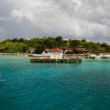By George Nicholson and Anastasia Ramjag
Op-Ed Contributors
The topic of vulnerability is one that has been on the agenda of the countries within the Greater Caribbean, and in particular those of the insular Caribbean for a long time.
In the context of disaster risk reduction, vulnerability formally refers to “the characteristics of a person or group and the situation that influences their capacity to anticipate, cope with, resist, and recover from the impacts of a natural hazard.
The concept is relative and dynamic, and in many cases is intrinsically associated with poverty.
It has also long been recognised that vulnerability can be categorised into three different subtypes: physical vulnerability to the actual environment; social vulnerability which affects the population’s societal, economic and administrative structures; and human vulnerability, a combination of the former two.
The dominant view here is that a real disaster occurs when an underprivileged population is exposed to a hazard of any type. Implicit in this perspective is “differential vulnerability” or the recognisance that within a single society or community, there may exist differing levels of vulnerability among the different populations.
Given the impact that disasters have on regional economies, and notwithstanding the underlying complexities, political and social, one thing is certain: the countries of the Greater Caribbean must build their capacities as well as resilience in order to adapt to the threats of natural hazards.
Vulnerability encompasses an assortment of theories and features comprising sensitivity or predisposition to harm and lack of capacity to cope and adapt. It is no surprise then that the countries of the Greater Caribbean are, by and large, prone to natural disasters of great magnitude, given their location and geomorphology. Development trajectories, grounded in a history of colonisation, and other more recent geopolitical constructs have caused the countries to experience economic and social strife and have left suboptimal social structures which add to vulnerability. A great many of the sources of risks in the Latin American and Caribbean region are man-made, exacerbated by a pattern of socioeconomic development which has eschewed proper risk management policies, particularly in the aspect of physical planning.
As a result, when disasters occur, they exact a terrible toll. Based on data from the International Disaster Database, a natural disaster that inflicts damage equivalent to more than two percent of the affected country’s GDP, can be expected to hit the countries of the Eastern Caribbean at least once every two and a half years. Given the weak base upon which many economies stand, the economic repercussions from such an impact further perpetuates the cycle of risk and reduces the capacity of a country to recover.
A necessary consequence of the vulnerability perspective, therefore, is that policies which are aimed at addressing risk and vulnerability must also take into account the fact that there are differential impacts and outcomes of disasters. Although the sources of vulnerability are multiple and quite diverse, some of the most important factors that affect vulnerability include population growth and distribution, social diversity, as well as issues concerning equality or the lack thereof.
Given the global issues surrounding development aid and financing, areas that the region has typically relied heavily on during times of crisis, it has now become more urgent and critical for countries within the region to anticipate and plan for disaster risk in order to more effectively protect persons and communities, thus strengthening their resilience.
Funds allocated globally towards disaster related activities between 1980 and 2010 represent approximately 2% of total development assistance or some USD 90 billion. The lion’s share, or roughly 96%, was allocated to response and relief with 4% for risk management and prevention; a mere 0.07% of all development assistance. Notwithstanding the commitments made in the Monterrey Consensus towards increasing development assistance, these numbers are expected to shrink as donor countries insist that receipts take increasing responsibility for their own circumstances. In light of this, vulnerable countries need to take more dedicated action focused on tackling some of the underlying risk drivers such as poverty and inequality, rapid unplanned and uncontrolled urbanisation and poor land management.
Reducing vulnerability in this new paradigm will require a significant departure from traditional approaches and interventions, and should involve risk assessments through a thorough analysis of communities, including details of the most vulnerable areas in terms of productivity, residences and infrastructure, followed by a recommended course of risk reduction measures. The approach should involve integrating risk management into institutional frameworks across all government agencies, using development policy instruments, contingency plans and environmental management tools. A third component in the approach for moving towards reducing vulnerability – and perhaps the one that may yield the greatest impact – may be the development of a social cohesion agenda for the region of Latin America and the Caribbean.
The concept of social cohesion in disaster risk reduction is premised on the fact that it is importantly related to change and there must be a balance between incremental and transformational change for building resilience against hazards. Resilience is an adaptive mechanism and the capacity for change accrues from the combination of strengths, attributes and resources available to a community or a society that can be used for adaptation.
Particularly in the face of increased threats due to climate change, local resilience can be fostered by strong social networks that support effective preparation and response. Social networks and social cohesion, which are by and large built on trust, by extension provide for a diverse number of functions, and facilitate sharing of both expertise and resources across stakeholder groups.
Similarly, these networks can function to facilitate engagement of advocacy in promoting preventative behaviour, implicitly reducing vulnerability by leveraging the political capital and trust of the networks. Cohesion supports the concept of inclusive governance, a discourse which has become increasingly necessary, for the region, facilitating the inclusion of local and lay persons in shaping the agenda at different levels for adaptive management.
The approach however, is not without its own challenges. The participatory process can lead to loose institutional arrangements, which themselves are vulnerable to distortion and capture by vested external and internal interests. The network can become insular and self-referential, thus defeating the original intent as this would depart from the ability to innovate – a key element in any adaptive process. In the face of a disaster, the network can lose the trust and social capital developed, in turn leading to the demise of the network itself.
In light of the Sendai Framework for Disaster Risk Reduction, countries are urged to adopt several measures to reduce vulnerability. Taking this into consideration and in an attempt to reduce disaster risk and vulnerability, there is a need to address the existing challenges and prepare for future ones by strengthening disaster risk governance and coordination across relevant state institutions, as well as investing in the economic and social resilience of persons and communities. There should be enhanced work to reduce exposure and vulnerability preventing the creation of new risk and encouraging accountability at all levels.
Notwithstanding the ills associated with it, vulnerability can serve as a catalyst for increased levels of disaster awareness, which can drive better practices forward and have positive influences on the incorporation of disaster mitigation strategies in policy-making and regional agendas.
Although there have been a number of national, regional and international efforts to reduce vulnerability in the Greater Caribbean, natural disasters worldwide and especially within the region are expected to increase due to climate change. The Latin American and Caribbean region must adapt, through advancing disaster risk management, unified multi-sector long-term development planning, embracing new technologies and importantly, generating the political will to facilitate changes required.
George Nicholson is the Director of Transport and Disaster Risk Reduction and Anastasia Ramjag is the Research Assistant of the Directorate of Transport and Disaster Risk Reduction of the Association of Caribbean States. Any feedback or comments should be sent to feedback@acs-aec.org







